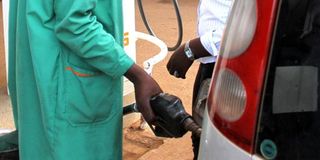Prime
Fuel, commodity prices dampen economic activity

The price of fuel has not gone down since January when it was scarce, it only keeps increasing. PHOTO | FILE
What you need to know:
- More than 41 percent of interviewed chief executive officers, procurement and purchase managers across business sectors, signalled a rise in costs of purchases with the most noticeable increases cited in cement, fuel, ink, paper, soap and sugar, among others .
Runaway commodity and fuel prices dampened economic activities during March, according to the Stanbic Purchase Managers’ Index.
In interviews conducted among chief executive officers, procurement and purchase managers across a section of business sectors, more than 41 percent of respondents signalled an increase in costs of purchases with the most noticeable increases cited in cement, fuel, ink, paper, soap and sugar, among others.
During March, the Purchase Managers’ Index indicated that all five surveyed sectors registered an increase in purchase prices with projections pointing to further increases in overall input costs.
The index noted that input prices have been rising since August last year.
Thus, during the period, the index dropped to 51.9 from 55.7 in February but remained above the 50 average score.
The score, according to Stanbic, signals continued business improvement but continues to be threatened by an increase in prices of a number of products, services and wholesale & retail sectors.
However, price decreases were registered in agriculture and construction products.
The Purchase Managers’ Index also noted that the health of the private sector has now strengthened in the last eight months with businesses registering new orders and employment rising again.
Mr Ferishka Bharuth, the Stanbic Bank economist for Africa region, said that whereas the index was lower than the score in February, it remains expansionary, supported by improvements in consumer demand, even as rising prices seem to have restrained demand.
“Higher prices were largely a function of increasing input costs, with companies increasing their selling prices for the seventh consecutive month,” he said, noting that output continued to expand for eight months due to the need to respond to rising customer demands.
The index also recorded improvements in new orders for the eighth successive month but indications suggest customers are experiencing difficulty in financing the orders.
Mr Ronald Muyanja, the Stanbic head of trading, said the absence of restrictions related to Covid-19 and signs of improving customer demand had helped businesses to expand their business activity but this is being threatened by reports of rising commodity prices.
However, during March, the index indicates new export orders declined, with drops reported among specific product categories.
Employment continued to grow for the fourth month since December with businesses responding to the need to deliver new orders.
The index also noted an improvement in purchasing activity and inventories in response to new orders, which have helped companies to keep on top of workloads and deplete outstanding business.
However, staff costs rose during the period for the third month in a row due to an increase in workforce numbers, with notable increases noted in construction, industry and services sectors. However, there were decreases in agriculture, wholesale and retail.
Increase in Business stock
During March, respondents noted that delivery time had reduced by 8 percent from 5 percent in February.
Business stock increased for the sixth month as new orders encouraged firms to rise inventory.
However, even amid the subdued environment, businesses remained optimistic that output will increase over the coming year, with close to 79 percent of respondents expressing a positive outlook.
Even as the period witnessed a drop in new export orders, export receipts increased for the fourth month, growing to $339.2m in January, which was an increase of 4.1 percent from $325.77m in December due to increase in export income from maize, sugar, cotton and beans.
Export volumes for maize increased from about 8,077 tonnes in December to more than 20,016 tonnes in January.




